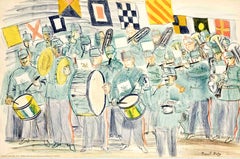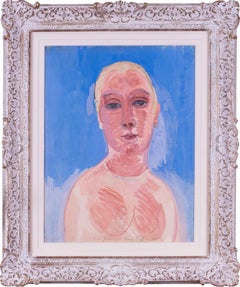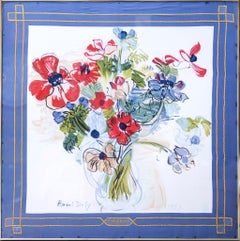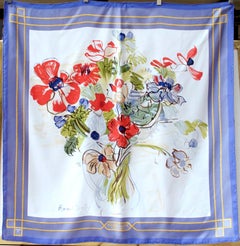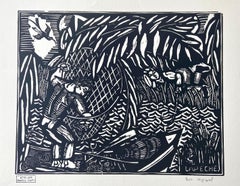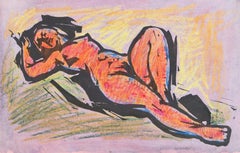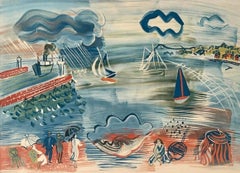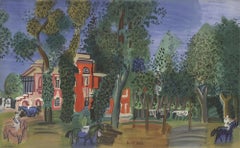Fauvist Art
1
to
1
5
2
2
1
4
2
1
1
2
1
3
Overall Height
to
Overall Width
to
73
18
3
3
3
4
3
3
2
2
2
1
1
1
1
1
1
1
1
1
1
1
7
1
1
2
127
28
22
19
15
3
2
2
2
1
Style: Fauvist
Artist: Raoul Dufy
The Band, School Prints, Raoul Dufy
By Raoul Dufy
Located in Auburn Hills, MI
Original Edition Lithograph on English cartridge paper. Edition: 3,000. Inscription: Signed in the plate and unnumbered. Excellent Condition; never framed or matted. Notes: Published...
Category
1940s Fauvist Art
Materials
Lithograph
Raoul Dufy's wife by Raoul Dufy, gouache on paper, 1915, French Fauvist portrait
By Raoul Dufy
Located in Petworth, West Sussex
A striking and very intimate work created by the renowned Fauvist artist Raoul Dufy in the early 20th century, depicting his wife in 1915. This artwork is a rare and very precious ge...
Category
Early 20th Century Fauvist Art
Materials
Paper, Gouache
"Anemones" Floral Silk Scarf
By Raoul Dufy
Located in Austin, TX
By Raoul Dufy
34.5" x 34.5"
Silk Screen Print on wearable scarf
Category
1950s Fauvist Art
Materials
Screen, Silk
"Anemones" Floral Silk Scarf, Unframed
By Raoul Dufy
Located in Austin, TX
By Raoul Dufy
34.5" x 34.5"
Silk Screen Print on wearable scarf.
Category
1950s Fauvist Art
Materials
Screen, Silk
La Peche lithograph (woodcut)
By Raoul Dufy
Located in Belgrade, MT
Raoul Dufy was an important multifaceted French artist who worked in a variety of media including painting, print making, mural design, theatre and costume design, upholstery, wall paper, ceramics, and fabric. In his paintings he often depicted the circus, equestrian scenes, Parisian cafe life, yachting scenes, colorful views of the French Riviera, and musical events in a distinctive style that combined the various artistic trends of the day, most notably Fauvism. Born in 1877 in Le Havre France, and after a year of military service in 1900, Dufy won a scholarship to the Ecole Nationale superieure des Beaux-Arts, in Paris, studying under Othon Friesz. He exhibited extensively throughout Paris and France at the various salons, including the Salon des Tuileries. For the 1937 Exposition Internationale in Paris, Dufy completed one of the largest paintings ever conceived, a 250...
Category
Early 20th Century Fauvist Art
Materials
Lithograph, Woodcut
La Baigneuse aux Papillons
By Raoul Dufy
Located in San Francisco, CA
This artwork titled "La Baigneuse aux Papillons" c.1930 in an etching on paper by French artist Raoul Dufy, 1877-1963. Unsigned as issue. Printed/publishe...
Category
Mid-20th Century Fauvist Art
Materials
Etching
Little Horses, Bathers and Seashell Petits Chevaux, Baigneuses et Coquillage
By Raoul Dufy
Located in London, GB
RAOUL DUFY 1877-1953
Le Havre 1877-1953 Forcalquier (French)
Title: Little Horses, Bathers and Seashell Petits Chevaux, Baigneuses et Coquillage, 1925
Technique: Original Hand Si...
Category
1920s Fauvist Art
Materials
Lithograph
Related Items
'Reclining Nude', California Post-Impressionist, de Young Museum, Fauve
Located in Santa Cruz, CA
Signed lower right, 'W.Georgetti', and created circa 1950.
Born in Italy, this California Post-Impressionist came to the United States at the age of one. Georgetti first worked as a merchant seaman to support his art studies and traveled all over the world accumulating sketches, many of which he later worked up into paintings. He made frequent visits to France, where he was influenced by the Post-Impressionists and, particularly, by the Nabis. An innovative theorist, Georgetti was the originator of the style known as California Fauvism. He exhibited widely and with success, both at exhibitions and at one-man shows (Oakland Art Gallery, 1942-44; Society of American Graphic Artists, NYC, 1944; Maxwell Galleries, 1940’s; de Young Museum...
Category
1950s Fauvist Art
Materials
Monotype, Paper, Crayon
LOWEST $ DIB Post Impressionist “LE HAVRE” Lithograph 1930 Figures and Seascrape
By Raoul Dufy
Located in New York, NY
Here I have the lowest authentic priced Raphl Dufy Le Havre for sale!
Originally purchased purchased from Sotheby’s
I’m 1984 for approx $3500, I have attached a photo of receipt ...
Category
1930s Fauvist Art
Materials
Lithograph
Vision of Paris, Lithograph from Mourlot Lithographe I
By Marc Chagall
Located in Washington, DC
Artist: Marc Chagall
Title: Vision of Paris
Portfolio: Mourlot Lithographe I
Medium: Lithograph
Year: 1960
Edition: Unnumbered
Framed Size: 22" x 19"
Image Size: 12 1/2" x 9 1/2"
Sh...
Category
1960s Fauvist Art
Materials
Lithograph
Nu Bleu II- plate signed - Henri Matisse Color Lithograph - 2007
Located in Sint-Truiden, BE
Color lithograph after the work by Henri Matisse, plate-signed by Matisse.
This lithograph was printed and published in 2007 using 100% cotton 300 g/m² BFK Rives paper. Artwork entirely made in France: from the production of the paper in Arches in the Vosges department, to the traditional lithographic printing process, one drawing for each different color, one color per press run.
The Blue Nudes...
Category
Early 2000s Fauvist Art
Materials
Handmade Paper
Amistat en els jardins del casino
Located in Barcelona, ES
The painting is being offered with a work and authenticity certificate
Category
1980s Fauvist Art
Materials
Paper, Ink
Kees Van Dongen Circus Performers 1900s Vintage Vibrant Figure Fauvist Signed
Located in Milwaukee, WI
"Les Artistes du Cirque" is an original painting in ink, watercolor, and gouache on paper by leading Fauvist artist Kees Van Dongen, signed in the lower right. In the piece, two circus performers stand against against a wall. On the left, a pale woman in a blue leotard with red flowers on the shoulder stands with her arms crossed, looking out at the viewer. The painter fills in her tights with delicate white brushstrokes, lending them an almost iridescent appearance. Her strawberry blond hair is piled on top of her hair according to the fashion of the period. On the right, an African man stands in a vivid orange toga, looking somewhere off to the left. His feet are clad in bright white shoes...
Category
Early 1900s Fauvist Art
Materials
Paper, Ink, Watercolor, Gouache
French Fauvist Provençal Village Scene. Mid-Century Oil on Board
Located in Cotignac, FR
French Mid 20th Century oil on board Fauvist view of a Provençal village street, probably near Nice in the South of France by Hyppolite Roger. The pain...
Category
Mid-20th Century Fauvist Art
Materials
Oil, Acrylic, Board
H 21.46 in W 14.97 in D 0.2 in
La Chevelure - Color Lithograph - 2007 - Henri Matisse
Located in Sint-Truiden, BE
Color lithograph after the work by Henri Matisse, plate-signed by Matisse from the edition of 200.
This lithograph was printed and published in 2007 in Paris using 100% cotton 300 g...
Category
Early 2000s Fauvist Art
Materials
Handmade Paper, Lithograph
H 22.84 in W 31.11 in
Edward Hopper's Dog - Nighthawks, Mychael Barratt, Limited Edition Print, Diner
Located in Deddington, GB
Edward Hopper’s Dog – Nighthawks by Mychael Barratt [2021]
limited edition
Silkscreen print
Edition of 100
Image size: H:50 cm x W:68 cm
Complete Size of Unframed Work: H:67 cm x...
Category
21st Century and Contemporary Fauvist Art
Materials
Paper, Screen, Silk
Mychael BarrattEdward Hopper's Dog - Nighthawks, Mychael Barratt, Limited Edition Print, Diner, 2021
Free Shipping
H 26.38 in W 32.68 in D 0.04 in
Woman in rocking chair oil on canvas painting fauvism nude
By Jordi Curos
Located in Barcelona, Barcelona
Jordi Curós Ventura (1930-2007) - Woman in rocking chair - Oil on canvas.
Work measurements 61x46 cm.
Frameless.
Jordi Curós Ventura (Olot, Girona, March 4, 1930) is a Spanish paint...
Category
1970s Fauvist Art
Materials
Canvas, Oil
Virgin Mary and child Jesus oil on board painting Christ
Located in Barcelona, Barcelona
Josep Lloveras Feliu (1922-2014) - Virgin Mary and child Jesus - Oil on panel
Oil measurements 60x49 cm.
Frame measurements 68x57 cm.
Josep Lloveras y Feliu, was a painter and sculp...
Category
1950s Fauvist Art
Materials
Oil, Board
Japanese Woodblock Artist French Lithograph Fauvist Colors School of Paris
By Shungo Sekiguchi
Located in Surfside, FL
Shungo Sekiguchi, (Japanese, 1911-2002):
Lithograph in color on Rives paper
Hand signed in pencil lower right, hand numbered
It appears to be the village of Montmarte in Paris
This was published by the Guilde de la Gravure, Paris, France and bears their GG blindstamp.
They were a mid century French art publisher and published many masters including Raoul Dufy, Max Erns, Jean Hans Arp, Ruffino Tamayo, Balthus, Gino Severini and Leonard Tsuguharu Foujita.
Shungo Sekiguchi was born 1911 in Japan. In 1932 Shungo Sekiguchi contributed to the print series "One Hundred Views of Great Tokyo" (Dai Tokyo hyakkei). Prints from watercolors published by Kaneda Shoten (Nihon Hanga Ken-kyusho). In 1935, Sekiguchi moved to Paris, France to study at the prestigious Ecole des Beaux Art of France with a scholarship of the French government. He studied together with two other Ecole de Paris Japanese artists, Takanori Ogisu and Tsuguji Foujita. He exhibited at the prestigious "Salon d'Automne" in Paris. In 1940 when Paris was occupied by the German Nazis, Shungo Sekiguchi returned to Japan, but kept his ties with France. In 1952 he exhibited at the famous Salon d'Automne and received an award. In 1959, he received an award at the Vicci International Art Contest. In 1964, he received the Diplome d'Honneur des at Jobiji International Art Show. His retrospective exhibition has been held in many places in Japan.
In 2002 the artist died in Japan. He is popular in Japan and several retrospective exhibitions were held in Japan. He was part of the Shin Hanga and Sosaku Hanga woodblock artists known for their woodcut prints and scrolls. Shin-hanga was an art movement in early 20th-century Japan, during the Taisho and Showa periods, that revitalized traditional ukiyo-e art rooted in the Edo and Meiji periods. He also worked as a book illustrator and did the artwork for the French edition of Le démon doré by Ozaki Kohyo. He is included in Helen Merritt and Nanako Yamada's classic book "Guide to Modern Japanese Woodblock...
Category
1950s Fauvist Art
Materials
Lithograph
Previously Available Items
1960 Raoul Dufy 'Paddock-Deauville'
By Raoul Dufy
Located in Brooklyn, NY
Paper Size: 24.5 x 39 inches ( 62.23 x 99.06 cm )
Image Size: 24.5 x 39 inches ( 62.23 x 99.06 cm )
Framed: No
Condition: A-: Near Mint, very light signs of handling
Additional...
Category
1960s Fauvist Art
Materials
Lithograph
"Flowers", original gouache on paper by Raoul Dufy (1877-1953)
By Raoul Dufy
Located in PARIS, FR
Raoul Dufy (1877-1953)
Gouache on paper
17 1/3 x 17 1/3 in. (with frame)
Monogram lower right
Raoul Dufy est un peintre et décorateur français de la première moitié du XXe siècle. ...
Category
1920s Fauvist Art
Materials
Paper, Gouache
H 17.33 in W 17.33 in D 1.19 in
The Undines, [Six Bathers], from: The Sea Les Ondines [Six Baigneuses]: La Mer
By Raoul Dufy
Located in London, GB
RAOUL DUFY 1877-1953
Le Havre 1877-1953 Forcalquier (French)
Title: The Undines, [Six Bathers], from: The Sea Les Ondines [Six Baigneuses]: La Mer, 1933
Technique: Original Hand ...
Category
1930s Fauvist Art
Materials
Lithograph
Fleurs - French Fauvist Botanical Flowers, Watercolor & Gouache by Raoul Dufy
By Raoul Dufy
Located in Marlow, Buckinghamshire
A simply beautiful botanical watercolour and gouache on paper by French fauvist painter Raoul Dufy. The work depicts flowers in yellow, red and green, with brown and green leaves. This work was executed by Dufy for the Maison Bianchini Ferier in Paris and was a design for wallpaper.
Signature:
Signed lower right/titled verso
Dimensions:
Framed: 20"x18"
Unframed: 14"x12"
Provenance:
This work is accompanied by a certificate from Mme. Fanny Guillon-Laffaille (T20-9575)
Raoul Dufy was one of a family of nine children, including five sisters and a younger brother, Jean Dufy, also destined to become a painter. Their father was an accountant in the employ of a major company in Le Havre. The Dufy family was musically gifted: his father was an organist, as was his brother Léon, and his youngest brother Gaston was an accomplished flautist who later worked as a music critic in Paris. Raoul Dufy's studies were interrupted at the age of 14, when he had to contribute to the family income. He took a job with an importer of Brazilian coffee, but still found time from 1892 to attend evening courses in drawing and composition at the local college of fine arts under Charles Marie Lhullier, former teacher of Othon Friesz and Georges Braque. He spent his free time in museums, admiring the paintings of Eugène Boudin in Le Havre and The Justice of Trajan in Rouen. A municipal scholarship enabled him to leave for Paris in 1900, where he lodged initially with Othon Friesz. He was accepted by the École des Beaux-Arts, where he studied under Léon Bonnat, whose innate conservatism prompted Dufy to remark later that it was 'good to be at the Beaux-Arts providing one knew one could leave'.
And leave he did, four years later, embarking with friends and fellow students on the rounds of the major Paris galleries - Ambroise Vollard, Durand-Ruel, Eugène Blot and Berheim-Jeune. For Dufy and his contemporaries, Impressionism represented a rejection of sterile academism in favour of the open-air canvases of Manet, the light and bright colours of the Impressionists, and, beyond them, the daringly innovative work of Gauguin and Van Gogh, Seurat, Cézanne, Toulouse-Lautrec and others. Dufy was an out-and-out individualist, however, and was not tempted to imitate any of these artists. He produced, between 1935 and 1937, Fée Electricité (Spirit of Electricity), the emblem for the French utilities company Electricité de France (EDF).
Dufy visited the USA for the first time in 1937, as a member of the Carnegie Prize jury. In 1940, the outbreak of war (and his increasingly rheumatic condition) persuaded him to settle in Nice. When he eventually returned to Paris 10 years later, his rheumatism had become so debilitating that he immediately left for Boston to follow a course of pioneering anti-cortisone treatment. He continued working, however, spending time first in Harvard and then in New York City before moving to the drier climate of Tucson, Arizona. The cortisone treatment was by and large unsuccessful, although he did recover the use of his fingers. He returned to Paris in 1951 and decided to settle in Forcalquier, where the climate was more clement. Within a short time, however, he was wheelchair-bound. He died in Forcalquier in March 1953 and was buried in Cimiez.
Between 1895 and 1898, Raoul Dufy painted watercolours of landscapes near his native Le Havre and around Honfleur and Falaise. By the turn of the century, however, he was already painting certain subjects that were to become hallmarks of his work - flag-decked Parisian cityscapes, Normandy beaches teeming with visitors, regattas and the like, including one of his better-known early works, Landing Stage at Ste-Adresse. By 1905-1906 Friesz, Braque, Matisse, Derain, Vlaminck, Van Dongen and Rouault were described collectively as Fauves (the wild beasts). What they had in common was a desire to innovate, but they felt constrained nonetheless to meet formally to set out the guiding principles of what promised to be a new 'movement'. Dufy quickly established that those principles were acceptable; moreover, he was most impressed by one particular painting by Henri Matisse ( Luxury, Calm and Voluptuousness) which, to Dufy, embodied both novelty and a sense of artistic freedom. Dufy promptly aligned himself with the Fauves. Together with Albert Marquet in particular, he spent his time travelling the Normandy coast and painting views similar to the latter's in both style and approach. Examples of work from Dufy's Fauviste period include variations on his Flag-Decked Street in Le Havre; Anglers.
By 1909, Dufy began to feel the need for a more structured compositional approach than that afforded by Fauvist arabesques and for a more differentiated approach to colour. After spending some time with Braque at l'Estaque, he started to take an interest in Cubism and more particularly in the work of Cézanne. He applied this new awareness to his own Green Trees in l'Estaque and Bathers, as well as to a series of paintings of the Bois de Boulogne, some model studies and some still-lifes. Dufy was attracted to a 'return to form', an aspiration he shared with Friesz, Derain and Vlaminck, and this showed in a series of compositions on the theme of The Studio. In the first instance, the studio in question was in the Rue Séguier, but Dufy would return to the theme on several subsequent occasions, painting the studio in the Impasse Guelma in Pigalle, his own studio in Le Havre, and his two studios in the Rue de la Poste and the Place Arago in Perpignan, where he worked from 1940 to 1950. The 'Munich period' works are characterised by a muted and more sombre colour palette and by a draughtsmanship that owes much to Cézanne in terms of spatial composition. On his return from Munich, Dufy settled into a 'Cézanne manner' which would typify his work until he found his own individual signature.
Dufy struggled financially for several years, and as a result accepted an offer from the couturier Paul Poiret to set him up in a studio in the Avenue du Clichy, where he started to produce woodcut-based textile designs. Poiret's gowns and Dufy's textile designs were a runaway success and, with Poiret's blessing, Dufy went on to create designs for the Lyons-based silk manufacturing firm of Bianchini-Atuyer-Ferrier, working there between 1912 and 1914 and from the end of World War I until 1930. Dufy's contribution to the industry is credited with arresting its industrial decline. It also ensured that he was in sounder financial health. Not least, it did not compromise his artistic integrity; on the contrary, it enhanced his compositional sense and imbued his work with a freshness and a more subtle feeling for colour and texture.
He started work on several series of paintings, working and reworking the same theme until all its possibilities and variants were ostensibly exhausted. He worked on the various series sporadically: some were taken up, abandoned, then revived several years later, while others were developed in parallel. It is therefore difficult to assign specific dates to each given series. Suffice it to say, perhaps, that they developed from his first visit to Vence in 1919 and his increasingly familiarity with the Mediterranean region. Examples include Vence (1920-1922); Canoeists on the Marne River (1924); and Jetty at Trouville; Racing (1925 to 1935). Other series followed ( Harvest Time; Baie des Anges; Official Receptions; Baccarat Tables; Salle de l'Opéra), followed by Reclining Nudes, Hindus, and a plethora of views of the Midi, Provence and the Côte d'Azur, complete with casinos, carousels, carnival scenes, sea terrace views, palm trees, fountains, markets, fishmongers' stalls, and the rest.
In 1922, Dufy went to the races, principally to observe how his textile designs looked as a finished product worn by the elegant lady racegoers of the day. From then on he chose watercolours as his primary medium, not least because the watercolour variant permitted him to capture a general impression more quickly. In 1925, he produced 14 curtain designs featuring life-size reproductions of his favourite themes for exhibition at the Exposition Internationale des Arts Décoratifs. Between 1930 and 1933, he produced successive versions of a mural 5 by 55 feet (1.5 by 16.5 metres) which developed the theme of the Itinerary from Paris to Ste-Adresse and the Sea. In 1935, the French utility Electricité de France commissioned him to produce a painting for its pavilion designed by the architect Mallet-Stevens for the 1937 Exposition Internationale. The commission came at a juncture when electricity was the new 'magic medium'. Dufy's approach was to conceive a Spirit of Electricity to symbolise this, and he worked assiduously for two full years collecting documentation and making preliminary sketches for a gigantic composition that measured no less than 33 by 197 feet (10 by 60 metres).
Between 1940 and 1950, Dufy went on to develop what would prove to be one of the most important series of all, his Orchestras and Concerts, featuring large orchestras and chamber music trios, quartets and the like. He had assembled from 1930 innumerable sketches of Conservatory musicians, sketched from above during rehearsals when Dufy would typically sit behind the percussion section. Following his move to Perpignan, he painted nudes, clowns, landscapes and, not least, views of wheatfields recorded while staying with Roland Dorgelès in Montsaunes in the Haute-Garonne. He also started work on the extended series entitled Cargots Noirs (1948-1952) which, painted at the end of his career, appears in some respects to be a reprise of his early views of Ste-Adresse. In these Cargots noirs, as elsewhere in his work, Dufy was at pains to 'generate light from black'. In 1943, he painted a rejoinder to Auguste Renoir's Bal du Moulin de la Galette and a Beautiful Sunday (which Dufy himself considered to be his finest work). He designed sets in 1944 for Armand Salacrou's Les Fiancés du Havre (Betrothal in Le Havre), presented at the Comédie Française. In 1946 tapestries designed by Dufy in Madame Cuttoli's studio featured at the Exhibition of French Tapestry and in 1952 he produced stage sets for Jean Anouilh's Ring Around the Moon.
Over time, Dufy's work evolved substantially in terms of materials and technique. In addition to his textile designs and ceramics, produced initially in co-operation with Artigas and occasionally co-signed by Jean-Jacques Prolongeau, he produced countless drawings, some 4,000 watercolours and around 2,000 paintings. Additionally, he practised woodblock engraving from 1920, followed by copper etchings and lithographs to illustrate a whole range of literary works, including Fernand Fleuret's Second-hand Goods (hand-coloured in 1907 but not published until 1923); Guillaume Apollinaire's Bestiary/Cortège of Orpheus (30 woodcut engravings exhibited at the 1910 Salon d'Automne and credited with revolutionising book publishing when the work subsequently went on sale in 1911); Emile Verhaeren's Poetic Legends of Flanders and Brabant (1917); Roger Allard's Martial Elegies of 1917; Rémy de Gourmont's Monsieur Croquant of 1917; Stéphane Mallarme's Madrigals (colour lithographs, 1920); Apollinaire's Assassinated Poet ( Le poète assassiné) of 1927; Eugène Montfort's Beautiful Girl ( La belle enfant) (93 etchings, 1930); Doctor Wine ( Mon docteur le vin), published in 1936 by the winesellers Etablissements Nicolas; Alphonse Daudet's Tartarin de Tarascon (1937); and various other publications, among them Gustave Couquiot's Garlic-Rubbed Soil ( La terre frottée d'ail), Brillat-Savarin's Aphorisms and Varia ( Aphorismes et Variétés), Colette's Herbarium ( our un herbier) and an edition of Virgil's Bucolica (the illustrations for which went unpublished). He also contributed to various periodicals prior to World War I, including Le Mot (The Word) and the Almanac of Arts and Letters ( L'Almanach des Lettres et des Arts).
Dufy's Races of 1925 saw him find favour with the general public. In Dufy's mind these watercolours had been intended only as preparatory sketches for subsequent oils, but then as indeed now the public at large appeared to prefer his watercolour work. Dufy himself repeatedly expressed the wish that his oils should have the fluency and transparency of his watercolours. On receiving the Spirit of Electricity commission in 1925, however, Dufy met with the painter and well-known restorer Jacques Maroger, who was currently researching techniques and materials used by the Old Masters. Together, they developed a soft emulsion that greatly facilitated Dufy's work. Dufy went on to use what he termed the Maroger Medium in his later work, aspiring to achieve a ductility and transparency comparable to that achieved in his watercolours. This is particularly evidenced in his Studios series painted in Perpignan, which traces the history of light. Here, Dufy painted themes close to his heart, portraying no fewer than 125 life-sized historical figures who each contributed in some way or another to the study of light and illumination, together with related phenomena such as lightning, rainbows and the aurora borealis, and featuring additional themes drawn from antiquity, the history of agriculture and navigation, music and contemporary life. Between 1937 and 1940, Dufy and Friesz painted decorative compositions for the bar in the Palais de Chaillot on the theme of the River Seine, and Dufy himself painted additional decorative compositions for the monkey-house in the Botanical Gardens in Paris.
Dufy's colours are applied flat and in direct juxtaposition. It is significant that from around 1937 he prepared his canvases and other surfaces by dividing them into three broad horizontal bands in three different colours to create successive planes of space and colour. Thus, the lowest zone might indicate the position of spectators at a racecourse, the middle zone would be reserved for the horses, while the upper or third colour zone would be reserved for the background landscape. By the start of the 1940s, he had abandoned this tri-zonal colour template in order to experiment with luminous colour spread thinly and evenly over the entire surface of the composition, with the components of the painting sketched in on top. Dufy's colours do not necessarily coincide with his outlines: the colour stops short of the outline of the image or bleeds across it, thereby creating the illusion of movement. This element of Dufy's style came to be much imitated.
In his early years, Dufy exhibited at the Salon des Artistes Français in 1901 ( End of the Day in Le Havre), and the following year his painter friend Maurice Delcourt introduced him to Berthe Weill, who purchased one of Dufy's pastels and exhibited examples of his work in her gallery. Dufy went on to exhibit at the Salon des Artistes Indépendants from 1903 to 1911 and then again in 1913, 1920 and 1923. Maurice Denis acquired one of Dufy's paintings exhibited at the 1903 Salon. In 1921, Dufy exhibited seven textile designs at the Salon des Artistes Décorateurs and in 1925 he showed at the Exposition Internationale des Arts Décoratifs. His Spirit of Electricity was exhibited at the 1937 Exposition Internationale in Paris. In 1946, examples of his work featured at the Exposition de la Tapisserie Française, an exhibition of French tapestry held at the Musée National d'Art Moderne in Paris. His work has also appeared in thematic exhibitions, notably in 1999 at Fauvism or 'Trial by Fire': The Eruption of Modernity in Europe ( Le Fauvisme ou 'l'épreuve du feu'. Éruption de la modernité en Europe), an event held at the Musée d'Art Moderne de la Ville de Paris.
His first solo exhibition was held at the Berthe Weill gallery in 1906. In 1921, he exhibited solo at the Galerie Bernheim Jeune and, in 1923, he featured in a one-man show at the Galerie du Centaure in Brussels. An exhibition of his watercolours followed in 1926, also at the Galerie Bertheim Jeune. In 1944, Louis Carré took on the mantle of Dufy's agent. Dufy subsequently exhibited in a solo retrospective at the Museum of History and Art in Geneva in 1952, followed by Venice, where he was awarded the Grand Prix at that year's Biennale (Dufy donated part of his prize to an Italian artist to enable him to travel to France and to a French artist, Charles Lapicque, to enable him to spend time in Venice).
Following his death, numerous exhibitions of his work took place, including a major retrospective at London's Hayward Gallery in 1983; an exhibition of his collected works at the Palais de Congrès in Nice in 1985; an exhibition of works from his Fauvist period at the Musée de l'Annonciade in St-Tropez in 1987; at the Villa Medicis in Rome in 1995; at an exhibition of his major works at the Pierre Gianadda Foundation in Martyigny (Switzerland) in 1997; at Dufy: The 1930s ( Dufy, les années 30), organised by the Electricté de France Foundation at the Espace Electra in Paris in 1997; at the Musée des Beaux-Arts in Nancy in 2002; at Raoul Dufy in a Fresh Light ( Raoul Dufy, un autre regard), an exhibition coordinated by the Dina Vierny Foundation at the Musée Maillol in Paris in 2003; and at Raoul Dufy: From Motif to Colour ( Raoul Dufy. Du motif à la couleur), an exhibition commemorating the fiftieth anniversary of Dufy's death, which was held successively at the Musée Malraux in Le Havre, the Modern Art Museum in Céret and the Museum of Art and Industry in Roubaix.
Museum and Gallery Holdings:
Amsterdam (Stedelijk Mus.): Paddock
Baltimore (MA): Haras du Pin
Basel (Kunstmus.): Regatta (1938); View of Ste-Adresse (1924); Deauville (1929)
Chicago (AI): Open Window, Nice (1928); Villerville (1928); Marne River at Nogent (1935)
Copenhagen (Statens Mus. for Kunst): Sun Effect on the Water at Ste-Adresse (1906); Interior with a Hindu Girl (1930)
Le Havre (Mus. Malraux): Yacht with Flags (1904); Jeanne among the Flowers (c. 1907); Blue Percherons (1925); Bathers, Cargo Boat, Yachts and Butterflies (1925-1927); Square in Hyères with Obelisk and Bandstand (1927); Veranda at Villerville (1930-1935); Nogent: Pink Bridge and Railway Track (1933); Full-length Nude with Paintings (1943); Self-portrait (1945); Gaston Dufy, Soldier (1950)
London (Tate Collection): The Baou de St-Jeannet (1923, oil on canvas); The Wheatfield (1929, oil on canvas); Deauville, Drying the Sails (1933, oil on canvas); The Kessler Family on Horseback (1932); two studies in gouache
Lyons (MBA): Boat with Flags (c. 1906); Black Cargo Boat (1952)
Marseilles (Mus. Cantini): Martigues Harbour (1904); Trees at l'Estaque (1908); Arcades at l'Estaque (1908); Statue with Two Red Vases (1908); Tuilerie St-Henri, or The Factory (1908)
Nantes (MBA): Port of Le Havre (1906)
New York (MoMA): Anglers (c. 1908); Yachts at Ste-Adresse (1912)
Nice: Vence (1919-1920); Homage to Claude Lorraine (1927); Portrait of Madame Raoul Dufy (1930); May in Nice (1930-1933); Harvest Evening (1935); Fireworks at La Jetée Casino (1947); Major Concert (1948); Nude at the Piano (1949); Port of Marseilles (1950); Homage to Claude Debussy
Paris (MAMVP): Deserted Garden (1913); Taormina (1923); Banks of the Marne (1925); Nautical Festival, Le Havre (1925); Jetty, Honfleur (1928); Nude on a Blue Ground (1930); Spirit of Electricity (1936-1937, 10 m x 60 m)
Paris (MNAM-CCI): Café Terrace, Martigues (1904); Beach at Ste-Adresse (1904); Posters at Trouvilles (1906); Village Street (1906); Flag-Decked Street, Le Havre (1906); Fourteenth of July (1906); Lady in Pink (1907-1908); Aperitif Time at the Café, l'Estaque (1908); Boats in Marseilles Harbour (c. 1910); Still-life with White Tower (1913-1947); Fisherman with Net (1914); Three Bathers (1919); Acrobats on a Circus Horse (1923-1924); Sea at Le Havre (1924-1925); Paddock at Deauville (c. 1930); Riders in the Woods (1931); Apple Trees in Normandy (1932); National Funeral of President Paul Painlevé at the Pantheon (1933); Amphitrite (1935-1953); Royal Coach...
Category
1910s Fauvist Art
Materials
Paper, Watercolor, Gouache
Paysage de Maroc
By Raoul Dufy
Located in Palm Desert, CA
A painting by Raoul Dufy. "Paysage de Maroc" is a Fauvist painting, water color on paper in an earth tone palette of blues, greens, and browns by French artist Raoul Dufy. The work i...
Category
Early 20th Century Fauvist Art
Materials
Watercolor
Raoul Dufy Ascot 1935 Lithograph
By Raoul Dufy
Located in San Francisco, CA
Raoul Dufy: 1877-1953. Very important early 20th century French modern Fauvist painter. This colorful gem is titled Ascot and dated 1935 and signed, all 3 in the stone. It is matted ...
Category
1930s Fauvist Art
Materials
Lithograph
1925 crayon on paper drawing of a nude by Post impressionist Raoul Dufy
By Raoul Dufy
Located in Petworth, West Sussex
Raoul Dufy (French, 1877 – 1953)
Vénus à la Coquille
Circa 1925
Black crayon on paper laid down
26 x 19.3/4in. (66 x 50cm.)
Provenance: From the family of Cavailles
Expertise: Thi...
Category
Early 20th Century Fauvist Art
Materials
Paper, Crayon
H 26 in W 19.75 in D 1 in
LA CHASSE (THE HUNT)
By Raoul Dufy
Located in Portland, ME
Dufy, Raoul. LA CHASSE (THE HUNT). Woodcut, c. 1925. Edition of 220 stamped with the estate stamp "Atelier Raoul Dufy." 8 1/4 x 25 inches, framed. In excellent condition.
Category
1920s Fauvist Art
Materials
Woodcut
Les Baigneuses - Original Lithograph by Raoul Dufy - 1925
By Raoul Dufy
Located in Roma, IT
Fine black and white lithograph on China paper. Signed on plate on lower-right margin.
Modern artwork representing the bathers swimming.
Excellent conditions, including a ivory colored cardboard passe-partout (cm 35 x 50).
Dufy Raoul...
Category
1920s Fauvist Art
Materials
Lithograph
H 11.03 in W 14.57 in D 0.04 in
Horse Races at Ascot, Study of Horses and Riders
By Raoul Dufy
Located in Norwich, GB
A unique chance to own TWO original, authenticated drawings by Raoul Dufy (1877-1953) - at an affordable price!
I think I need not introduce the artist, who is arguably one of the most important important figures in 20th Century French painting.
The subjects of the works presented here are lovely: horses and riders, and spectators in top hats and morning suits...
Category
1930s Fauvist Art
Materials
Paper, Ink, Graphite
LA CHASSE (THE HUNT)
By Raoul Dufy
Located in Portland, ME
Dufy, Raoul. LA CHASSE (THE HUNT). Woodcut, c. 1925. Edition of 220 stamped with the estate stamp "Atelier Raoul Dufy." 8 1/4 x 25 inches, framed. In excellent condition.
Category
1920s Fauvist Art
Materials
Woodcut
Springtime in Paris - Original tall lithograph poster - 1966
By Raoul Dufy
Located in Paris, FR
Raoul DUFY
Springtime in Paris
Original poster from 1966
Printed as a photo-lithograph
Based on the painting "The Screen" exhibited at the Musée d'Art Moderne de la Ville de P...
Category
1960s Fauvist Art
Materials
Lithograph
Free Shipping
H 39.38 in W 24.41 in
Fauvist art for sale on 1stDibs.
Find a wide variety of authentic Fauvist art available for sale on 1stDibs. Works in this style were very popular during the 21st Century and Contemporary, but contemporary artists have continued to produce works inspired by this movement. If you’re looking to add art created in this style to introduce contrast in an otherwise neutral space in your home, the works available on 1stDibs include elements of blue, orange, purple, green and other colors. Many Pop art paintings were created by popular artists on 1stDibs, including Charles Cobelle, (after) André Derain, Evelyne Ballestra, and (after) Pierre Bonnard. Frequently made by artists working with Paint, and Oil Paint and other materials, all of these pieces for sale are unique and have attracted attention over the years. Not every interior allows for large Fauvist art, so small editions measuring 3.94 inches across are also available. Prices for art made by famous or emerging artists can differ depending on medium, time period and other attributes. On 1stDibs, the price for these items starts at $1 and tops out at $2,835,000, while the average work sells for $1,532.
Recently Viewed
View AllMore Ways To Browse
Wall Fresco
19th Century Spanish Paintings
Greek Woman
Oil Painting Man 19th
Native American Gold
Cut Paper Wall Art
Antique Painting Auction
Antique Painting Auctions
Lady Just
Gold Leaf Painting Japan
Japanese Painting Gold Leaf
Sea Life Gold
Canvas Midcentury Print
Russian Vintage Fashion
Costa Vintage
Coat Mans
Head Of Man Sculpture
Sculpture 1942
